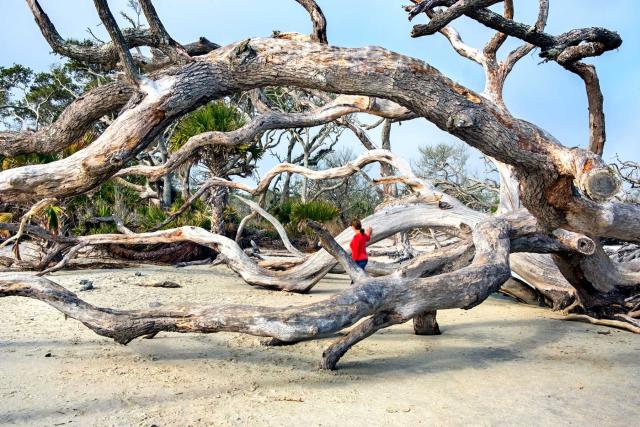Driftwood Beach shows travelers that there’s a beautiful side to this barren landscape that every traveler should experience.

There’s something palpably spiritual about trees. Of course, trees are the lifeline of our planet. Without them, life as we know it would cease to exist. With reduced amounts of oxygen in the air we breathe, our lungs would not have enough to run on. But they also come with an attractive mystique that’s just so appealing. Their majestic awe, their studied quietness, their ambivalence, their timelessness, their unbending firmness, and their tranquil aura—are all things that we want, yet strangely—elude us. For those who get blown away by trees, a trip to Driftwood Beach should be a compulsory adventure.
Driftwood Beach has a pale, attractive look of a forgotten place. And true to its look and feel—the place is more of a shrine of leafless trees. It’s located in Georgia, home to several small, charming towns all with a rustic feel that’s so easy to fall in love with.
The Majestic Trees Of Driftwood Beach
A leafless tree looks dull, plain, and unappealing—until one visits Driftwood Beach where huge, gnarled oaks, look weirdly, mysteriously attractive. Trees, like animals in George Orwell’s masterpiece, are not created equal. A weeping willow, bottle brush, or maple, each exudes its own personality, its own individuality. Yet in the pecking order of trees, oaks are not just trees. We’ve always held them in reverential awe. Two things about them stand out: they live for long, up to 1,000 years by some estimates. They are also huge and sturdy, the quintessential image of power and strength. They feature in the myths of classical Greece as well as those of ancient Rome. After a victorious war, a returning Roman general would receive a garland made of oak tree leaves. The Druids, the fabled order who were at the intellectual head of ancient Celtic society, are known to have worshipped oak trees. Actually, the Celtic meaning of their name was— “knower of oak trees.”

Yet at Driftwood Beach, these terrestrial behemoths lie ominously down and dead, as if struck down by the gods. Their now grey trunks have lost all color. Their pale leaves sparsely dot the sandy beach. But even in death, they maintain their power and poise, as if daring to live on. Besides them are a few pine trees, which, though not as fabled or famous, exude their own unique appeal. Misery, we’ve always been told, loves company. Even the slender palm trees are not at their vibrant best.
Some oak trees are only partially buried under a heap of soft sand. Others are lying gloomily on top as if they’ve refused to be buried. And the ones that still stand, cut the image of mysterious bleakness, not a single green shade can be seen either on the craggy boughs or on the grey trunks. They seem like they want to both tell of the past and warn of the future. In some places, one has to climb over them or crawl underneath. Still, some fallen boughs are high enough that one won’t have to bend or jump over—but walk straight under.
All this is eerily beautiful and weirdly attractive. Turning the back on this strange spectacle suddenly calls for some effort. And carrying a branch, perhaps as a souvenir, is not permitted. The only memorial to take with oneself is a picture. For the photogenic, Driftwood Beach is like some blasted paradise. Couples come to tie the knot here and take wedding photos. It’s quiet and secluded, just the dream environment for a wedding location. Soon, it might just be among the most photographed places on earth.
One may ask why (or how) nature set up such an evocative scene. The explanation points to that old foe—called erosion. With significant erosion, especially on the northern sides of the beach, the soil cover that remained around the trees was woefully deficient to sustain the life of the trees. The trees, therefore, dried up and died. The puzzling question is why the drift woods were not swept by the tides to the sea—even when they had fallen. The answer is that the waves around Jekyll Island are usually gentler and a bit calmer hence not strong enough to sweep the beachfront debris. This has something to do with the island being quite a distance from the continental shelf.
- Distance of Driftwood Beach From Savannah Georgia: The distance is about 95 miles or 152 kilometers.
Driftwood Beach lies on Jekyll island, one of the scenic quartet of barrier islands on the southwestern coast of Georgia. One can find his or her way easily to the beach as there are a good number of access routes, especially on North Beachview Drive. But to access Jekyll Island itself which is home to Driftwood Beach, the Jekyll Island Causeway is the main gateway. This road joins U.S. 17 at the southern end of the Sidney Lanier Bridge. For one who wants to experience a different, beautiful side of this remote shoreline, a visit to Driftwood Beach will be a rewarding adventure.
Source: thetravel.com









